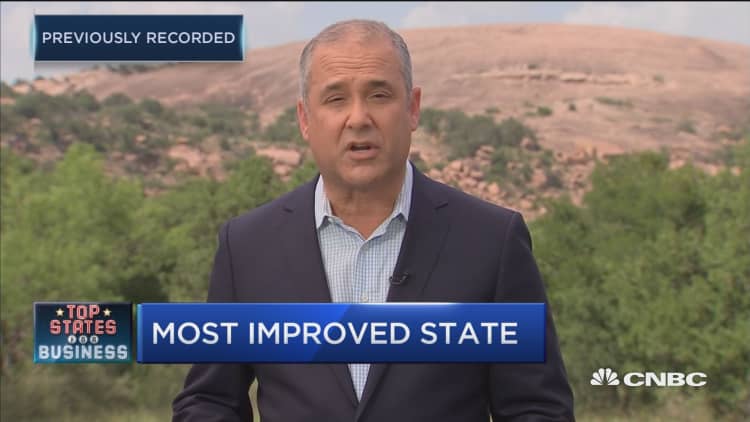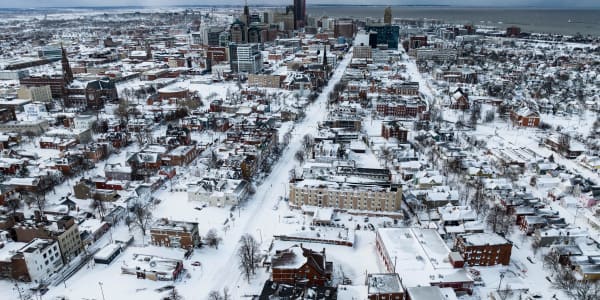Though one year does not a trend make, New York has come out the clear winner as this year's most improved state, rising 11 notches to No. 27 from last year's 38 spot, in CNBC's 2018 America’s Top States for Business rankings. But make no mistake; New York still sits in the bottom half of our rankings and is still chock full of problems: It is expensive, its infrastructure is crumbling, and regulations can be stifling.
But something is happening in the Empire State.
“We have a substantial workforce, we have an incredibly robust system of higher education, and we have high-tech industries across the board and across the state,” said Howard Zemsky, New York State Commissioner of Economic Development and the CEO of Empire State Development — the state’s business promotion arm.
By the numbers, the changes are subtle, to say the least, but they are occurring virtually across the board. New York’s rankings improve or stay the same in 9 of our 10 categories of competitiveness, with the only decline in Business Friendliness. And it drops just three places there, to No. 48, because of a tough legal climate. The U.S. Chamber Institute for Legal Reform gives the state poor marks on damage awards, impartiality of judges and jury competence.
New York’s biggest gain is in the Economy category, where it improves 10 places to No. 23. Growth is still sluggish, with state GDP rising just 1.1 percent last year and staying virtually flat to start out this year. But the housing market is showing real signs of life, with prices in the first half of the year rising 8.6 percent from the same period one year ago, according to the New York State Association of Realtors. And foreclosure activity leveled off last year as the market stabilized. Affordability is still an issue, and it threatens to get worse as prices rise. But a strong and stable housing market bodes well for business.
More from America's Top States for Business:
The Empire State's appeal
Gov. Andrew Cuomo, fighting a tough reelection battle while also burnishing his resume for a possible presidential run, is touting big, high-profile infrastructure projects like the $4 billion Mario Cuomo Bridge over the Hudson River, nearing completion north of New York City, and the $8 billion renovation of New York’s LaGuardia Airport. He also recently announced nearly $60 million in state and federal funding for rural transportation projects.
“Transportation infrastructure is the lifeblood of our economy and the key to future growth,” Gov. Cuomo said in making the announcement. For now, New York’s infrastructure remains among the nation’s worst. But the new projects could eventually change that.
The state’s other longstanding issues are more complicated. High costs are pretty much a fact of life in an old, densely populated state. New York is offsetting some of those costs with billions of dollars in incentives and tax breaks—more than any other state.
Besides, officials point out, New York is a big and diverse state, with plenty of pockets of affordability.
“You can’t really paint the state with a broad brushstroke on that,” Zemsky said.
And he said the state tax system is increasingly business-friendly.
“We’ve lowered taxes on businesses. There are no taxes for manufacturing companies in New York State,” he said.
New York’s base corporate income-tax rate is 6.5 percent. In addition to the complete tax break for manufacturers, there are reductions for emerging technology companies and small businesses.
New York is the nation’s most heavily unionized state, which cost it some points in our Workforce category. But that workforce is also the best educated in the country, according to the Census Bureau, with nearly 44 percent of people over age 25 attaining a bachelor’s degree or higher.
New York’s education system is among the best in the nation, according to our study, and only California is home to more companies in the Standard and Poor’s 500. All told, there may be hope for New York.
'Silicon Valley of food'
Also surging higher is Idaho, which jumps nine spots to No. 11. The Gem State combines low costs and a business-friendly environment with a strong economy — GDP grew by 2.7 percent last year, and employment grew more than 3 percent.
The state is trying to position itself as the "Silicon Valley of food." The founder and CEO of Chobani, Hamdi Ulukaya, coined the phrase late last year when he announced a $20 million expansion at the company’s Twin Falls yogurt plant—billed as the largest yogurt processing facility in the world.
The state is also stepping up its pursuit of agricultural research dollars. Idaho brought in more than $14 million in U.S. Department of Agriculture grants last year. That is a relative pittance compared to big agricultural states like Iowa, Texas, and California. But it is a more than 30 percent increase from 2016.
Idaho improves or stays the same in 9 of our 10 categories of competitiveness this year, only slipping in Cost of Living as the economy there expands. The state does have issues, most notably its underfunded education system, ranked No. 40 in our study.
Other notable improvements in this year’s rankings include No. 20 Arizona (tied with South Dakota) and No. 33 Nevada, each rising six places overall, thanks to housing booms in both states.
Biggest losers in state rankings
The biggest decline in this year’s rankings belongs to No. 29 North Dakota, which slides 10 places from last year’s No. 19 finish.
North Dakota’s fall into the bottom half of the rankings is remarkable for a state that was America’s economic darling just a few years ago. The Peace Garden State peaked at No. 3 in our rankings in 2013, near the height of the domestic oil boom.
Lately, production in the state’s crucial Bakken Shale region has rebounded to levels not seen since 2015, thanks to the recent rise in oil prices. But the slump over the last two years did serious damage. The state’s economy grew by just one percent last year, and actually contracted by 1.3 percent in the first quarter of this year. Home prices barely budged last year, and job growth slowed to a trickle. No wonder the state drops to No. 44 in our Economy category. Meanwhile, college-educated workers fled the state for better opportunities elsewhere, costing the state dearly in our Workforce category.
The rebound in oil prices and the return of boom-level production could help North Dakota bounce back. If so, the state is well-positioned for a rebound. Evidence suggests that officials did not squander the proceeds from the boom — the state’s infrastructure is in relatively good shape, and its finances are sound. But this year’s study appears to show just how fragile North Dakota’s oil boom was.
Other notable drops this year include Kentucky, falling 7 spots to No. 42 overall. The Bluegrass State is facing a fiscal crisis, including a pension shortfall estimated to be as much as $40 billion.
New Hampshire drops six spots to No. 24. The Granite State is tops in the nation for business friendliness, and its workforce is among the best educated. The problem is that those workers are in critically short supply, with unemployment at just 2.7 percent in May.
Georgia falls five spots — and out of our top five — to No. 7 this year. The economy is still strong, but an uptick in costs and violent crime bruise the Peach State’s competitive edge.








